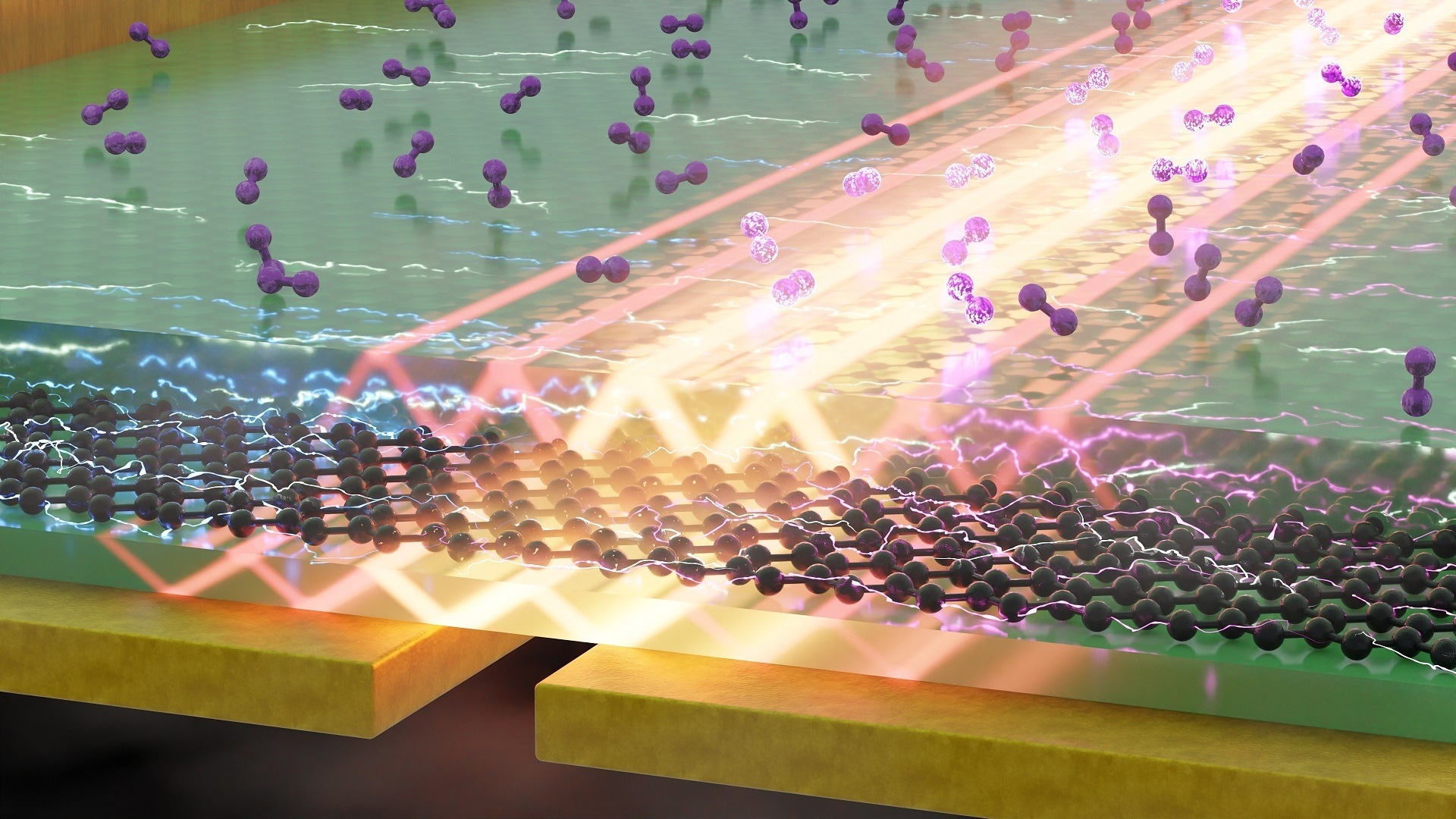Reviewed by Lexie CornerNov 19 2024
According to a study published in Nature Communications, researchers have created an extremely sensitive detector for identifying molecules based on their infrared vibrational “fingerprint.”
 Illustration of an on-chip molecular vibration sensor based on a graphene IR detector, where phonon polaritons (bright rays) enhance the molecular fingerprint signal encoded in the photocurrent. Image Credit: Dr. David Alcaraz, ICFO
Illustration of an on-chip molecular vibration sensor based on a graphene IR detector, where phonon polaritons (bright rays) enhance the molecular fingerprint signal encoded in the photocurrent. Image Credit: Dr. David Alcaraz, ICFO
This novel detector transforms incident infrared light into ultra-confined “nanolight” in the form of phonon polaritons within its active area. This process serves two critical functions: it increases the overall sensitivity of the detector and improves the vibrational fingerprint of a nanometer-thin molecular layer placed on top of it, making it easier to detect and analyze.
The device’s tiny design and room-temperature operation offer the possibility of constructing ultra-compact platforms for molecular and gas sensing applications.
Molecules can be distinguished from one another according to their distinct characteristics, which resemble fingerprints. When exposed to the proper light, each type of molecule vibrates at a distinct frequency and strength known as its resonance frequency, which usually happens at infrared frequencies.
This information can be used to distinguish between different types of molecules or gases, similar to how human fingerprints are used for identification. Identifying hazardous and toxic materials or gases can help protect us from potential threats.
Infrared fingerprint spectroscopy is a traditional method that identifies molecules by using infrared transmission or reflection spectra. However, detecting small amounts of material is challenging, as organic molecules are small compared to the infrared wavelength, resulting in weak scattering signals.
Surface-Enhanced Infrared Absorption (SEIRA) spectroscopy has been developed in recent years to address this issue. SEIRA spectroscopy amplifies molecular vibrational signals by utilizing the infrared near-field enhancement provided by rough metal surfaces or metallic nanostructures. Its primary advantage is the ability to measure and analyze very small quantities of material.
Recently, hyperbolic phonon polaritons in thin layers of hexagonal boron nitride (h-BN) have shown promise for increasing the sensitivity of SEIRA spectroscopy. Phonon polaritons are coupled excitations of electromagnetic waves and atomic lattice vibrations.
Previously, we demonstrated that phonon polaritons can be applied for SEIRA spectroscopy of nanometer-thin molecular layers and gas sensing, thanks to their long lifetimes and ultra-high field confinement.
Rainer Hillenbrand, Professor, CIC nanoGUNE
Despite its advantages, SEIRA spectroscopy remains a far-field method that requires large equipment, including light sources, SEIRA substrates, and infrared detectors, which are typically nitrogen-cooled. This limits its potential for miniaturization and on-chip applications due to its reliance on large instruments.
We have been investigating graphene-based infrared detectors that operate at room temperature, and we have shown that phonon polaritons can be electrically detected and can enhance detector sensitivity.
Frank Koppens, Group Leader, ICFO
A team of scientists has now demonstrated the first on-chip phononic SEIRA detection of molecular vibrations by combining these advancements. With theoretical support from Prof. Luis Martín-Moreno’s team at the Instituto de Nanociencia y Materiales de Aragón (CSIC-Universidad de Zaragoza) and Dr. Alexey Nikitin’s team at the Donostia International Physics Center, the experimental work by Nanogune and ICFO researchers made this achievement possible.
To eliminate the need for conventional large infrared detectors, the researchers used ultra-confined HPhPs to directly detect molecular fingerprints in nanometer-thin molecular layers through the photocurrent of a graphene-based detector.
One of the most exciting aspects of this approach is that this graphene-based detector opens the way towards miniaturization. By integrating this detector with microfluidic channels, we could create a true 'lab-on-a-chip', capable of identifying specific molecules in small liquid samples—paving the way for medical diagnostics and environmental monitoring.
Dr. Sebastián Castilla, Researcher, ICFO
Dr. Andrei Bylinkin, the study’s first author and a researcher at nanoGUNE, stated, “On-chip infrared detectors operating at room temperature could enable rapid molecular identification, potentially integrated into smartphones or wearable electronics” in the future.
He further added, “This would offer a platform for compact sensitive, room-temperature infrared spectroscopy.”
Journal Reference:
Bylinkin, A. et. al. (2024) On-chip phonon-enhanced IR near-field detection of molecular vibrations. Nature Communications. doi.org/10.1038/s41467-024-53182-9